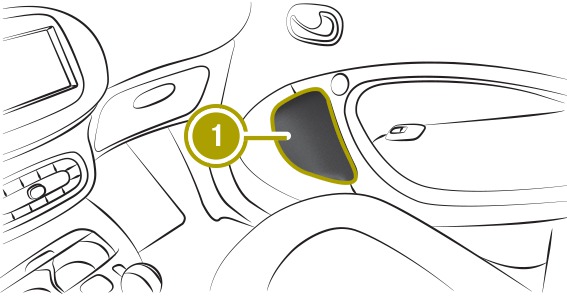- smart fortwo
- EQ fortwo
- 07/2021
When the hazard warning lights are switched on, all turn signal lamps will flash.
The airbag has been deployed.
The vehicle is braked heavily from a speed of more than 70 km/h and comes to a standstill.
The hazard warning lamps will switch off automatically if a speed exceeding 10 km/h is reached following maximum full-stop braking.

 .
. An unsecured fire extinguisher can be thrown around and jeopardise the operational and traffic safety of the vehicle.
In addition, the driver or other vehicle occupants could be injured.








The safety vest only meets the requirements defined by the legal standard if it is the correct size and fully closed when in use.
The safety vest must be replaced in the following cases:
it is damaged or dirt on the reflective strips can no longer be removed
if you exceed the maximum number of washes
if the fluorescence has faded
The safety vest is located in door stowage compartment  of the front passenger door.
of the front passenger door.

 .
. 
Warning triangle  is secured behind the driver's seat backrest with a Velcro fastener. Return it to this location after use.
is secured behind the driver's seat backrest with a Velcro fastener. Return it to this location after use.
 .
. Check the expiry date on the first-aid kit at least once a year. Replace the contents if necessary, and replace any missing parts.

First-aid kit (soft-sided)  is secured behind the driver's seat backrest with a Velcro fastener. Return the first-aid kit to this location after use.
is secured behind the driver's seat backrest with a Velcro fastener. Return the first-aid kit to this location after use.
 .
. QR codes are attached in the socket flap and on the opposite side on the B-pillar. In the event of an accident, rescue services can use the QR codes to quickly find the appropriate rescue card for your vehicle. The current rescue card contains the most important information about your vehicle in a compact form, e.g. the routing of the electric lines.
Further information can be obtained at Mercedes-Benz homepage - rescue card.
If you manipulate or bridge a faulty fuse or if you replace it with a fuse with a higher amperage, the electric line could be overloaded.
This could result in a fire.
Moisture may cause damage to the electrical system or cause it to malfunction.
Electrical components or systems could be damaged by incorrect fuses.
The electrical fuses disconnect defective circuits. If a fuse blows, all the connected components and their functions will fail.
Blown fuses must be replaced with fuses of the same rating, which you can recognise by the colour and fuse rating. The fuse ratings are listed in the fuse assignment diagram More.
If new fuses blow, the cause for this must be diagnosed and rectified at a qualified specialist workshop.
The tyres can overheat and cause a fire.
The driving characteristics as well as the steering and braking may be greatly impaired.
You could then lose control of the vehicle.
TIREFIT is a tyre sealant. TIREFIT is used to seal punctures of up to 4 mm, particularly those in the tyre tread, at outside temperatures down to -20°C.
The tyre sealant is pumped into the tyre.
The TIREFIT kit is located in the vehicle tool tray underneath the glove box.
The tyre inflation compressor weighs approximately 0.7 kg.
At a distance of approximately 60 cm from the tyre inflation compressor, the following sound pressure levels apply:
X-axis: 82.9 dB (A)
Y-axis: 84.3 dB (A)
Z-axis: 84.1 dB (A)
The tyre inflation compressor is maintenance-free. If there is a malfunction, contact a qualified specialist workshop.
The tyre sealant may be unable to seal the tyre properly, especially in the following cases:
there are large cuts or punctures in the tyre (larger than damage previously mentioned)
the wheel rims have been damaged
after journeys with very low tyre pressure or with flat tyres
Tyre sealant is hazardous to health and causes irritation. Do not allow it to come into contact with your skin, eyes or clothing, and do not swallow it. Do not inhale any vapours. Keep the tyre sealant away from children.
Observe the following if you come into contact with the tyre sealant:
A tyre temporarily sealed with tyre sealant impairs the handling characteristics and is not suitable for higher speeds.
The maximum permissible speed for a tyre sealed with tyre sealant is 80 km/h.
Affix the upper section of the TIREFIT sticker to the instrument cluster in a location where it will be easily seen by the driver.
Have the tyre sealant bottle replaced every four years at a qualified specialist workshop (see the use-by date on the bottle).
After use, excess tyre sealant may run out of the filler hose. This can cause stains.
Therefore, place the filler hose in the plastic bag that contained the TIREFIT kit.
Tyre sealant contains pollutants.
Comply with the manufacturer's safety instructions on the sticker on the tyre inflation compressor.
 in the ignition lock.
in the ignition lock.  . The selector lever lock can be manually released in the event of an electrical malfunction More.
. The selector lever lock can be manually released in the event of an electrical malfunction More.